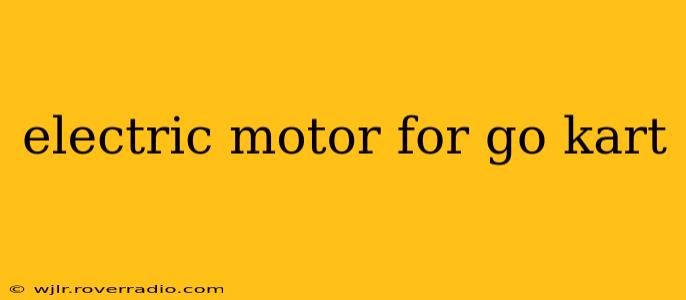Choosing the right electric motor for your go-kart is crucial for performance, safety, and enjoyment. This guide dives deep into the factors to consider, helping you select the perfect power source for your karting adventures. Whether you're building a new kart from scratch or converting an existing gasoline-powered one, this information will be invaluable.
What Size Electric Motor Do I Need for My Go-Kart?
This is perhaps the most frequently asked question. The answer isn't straightforward and depends on several factors:
- Kart Weight: A heavier kart will require a more powerful motor to achieve the desired speed and acceleration.
- Desired Top Speed: Higher top speeds demand more powerful motors.
- Terrain: Hilly terrain necessitates a motor with more torque to climb inclines effectively.
- Rider Weight: The weight of the driver significantly impacts the overall weight of the go-kart.
- Battery Capacity: The motor's power output is closely tied to the battery's capacity. A higher-capacity battery will allow for longer run times and more power delivery.
Generally, go-karts use motors ranging from 1kW to 10kW or more. A smaller motor (around 1-3kW) might suffice for a lightweight kart on flat terrain, while a larger motor (5kW+) is ideal for heavier karts, hilly courses, or those seeking higher speeds.
What Kind of Electric Motor Is Best for a Go-Kart?
Several electric motor types are suitable for go-karts, each with its advantages and disadvantages:
- Brushed DC Motors: These are relatively inexpensive and simple, but they have lower efficiency and shorter lifespans due to brush wear. They're often found in entry-level go-karts.
- Brushless DC Motors (BLDC): More efficient, powerful, and longer-lasting than brushed motors, BLDCs are the preferred choice for performance go-karts. They offer smoother operation and require less maintenance.
- AC Induction Motors: These motors are robust and highly efficient, but they typically require more complex controllers and are often more expensive. They are less common in go-karts but are a viable option for high-performance builds.
For most go-kart applications, a brushless DC motor (BLDC) offers the best balance of performance, efficiency, and longevity.
What Voltage Electric Motor Do I Need for My Go-Kart?
The voltage of your motor dictates the power it can draw and its overall performance. Common voltages include 24V, 36V, 48V, and 72V. Higher voltages generally mean more power, but they also require more robust and expensive controllers and batteries. The choice of voltage is often dictated by the battery pack you choose. It's crucial to select a motor and controller compatible with your chosen battery voltage.
What is the Best Electric Motor Controller for a Go-Kart?
The motor controller acts as the "brain" of your electric go-kart, regulating the power flow from the battery to the motor. It's essential to choose a controller that's compatible with your motor's voltage and amperage rating. High-quality controllers often feature features such as regenerative braking (recapturing energy during braking) and adjustable speed and torque settings.
Selecting the right controller is just as crucial as choosing the motor itself. A poorly chosen controller can limit your motor's performance or even damage it.
How Much Does an Electric Motor for a Go-Kart Cost?
The cost of an electric motor for a go-kart varies greatly depending on its power, type, and brand. You can find relatively inexpensive brushed DC motors, while high-performance BLDC motors can be significantly more expensive. It's best to set a budget and research motors within that range. Remember to factor in the cost of the controller, battery, and any necessary wiring and installation.
Conclusion
Choosing the right electric motor for your go-kart involves carefully considering several factors, including the kart's weight, desired speed, terrain, and budget. By understanding the different types of motors and their characteristics, you can make an informed decision and build or convert a go-kart that delivers an exhilarating and safe driving experience. Remember to always prioritize safety and adhere to all relevant regulations and safety guidelines.
